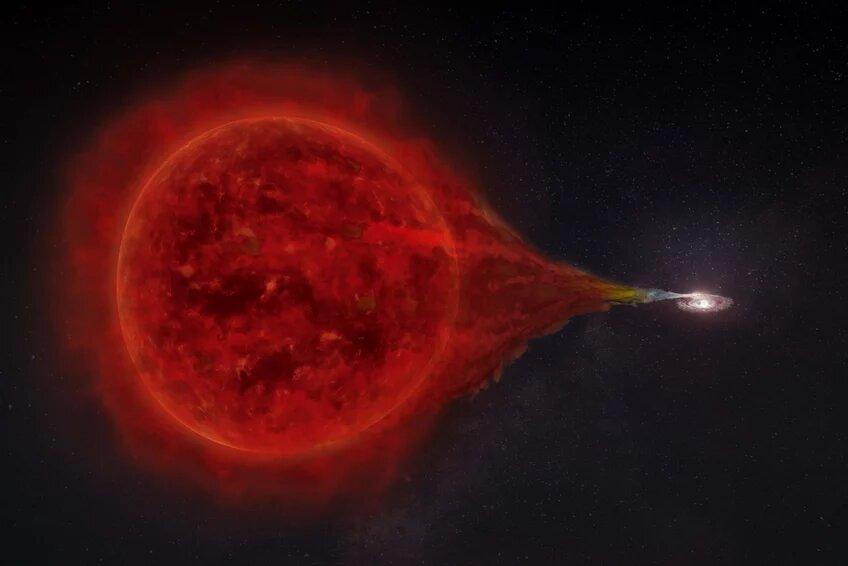Gamma-ray emission from a recurrent nova confirms a 2006 prediction

RS Ophiuchi is an unstable binary system formed by a red giant star and a white dwarf, which regularly experiences thermonuclear explosions on top of the white dwarf, called nova explosions
Located 5,000 light years from Earth, RS Ophiuchi (RS Oph) is an unstable binary system formed by a red giant star and a white dwarf. Every 15 to 20 years, enough material from the red giant builds up on the surface of the white dwarf to cause a thermonuclear explosion. In astronomy, these systems are known as novae, as they cause the sudden appearance of a bright, apparently "new" star.
RS Oph has recorded outbreaks in 1898, 1933, 1958, 1967, 1985, 2006 and 2021. In fact, all novae are recurrent, but only very few of them have recurrence periods short enough (shorter than 100 years) so that they have more than one recorded outburst.
Its last eruption in 2021 was observed by the Large Area Telescope (LAT) of the Fermi mission, the Cherenkov Telescope Array H.E.S.S. in Namibia and the MAGIC Cherenkov Telescopes in the Canary Islands (Spain). This was the first time an explosion like this was observed in the Milky Way in very high-energy gamma rays by ground-based telescopes.
The outbreak of RS Oph in 2021 confirms the predictions that Margarita Hernanz, researcher from the Institute of Space Studies of Catalonia (IEEC — Institut d'Estudis Espacials de Catalunya) at the Institute of Space Sciences (ICE-CSIC), made in 2006, about the emission of very high-energy gamma rays related to particle acceleration in this recurrent nova. This study was published in The Astrophysical Journal.
Particle acceleration was not considered feasible in novae until the observation of RS Oph, so it has become a key object for studying the microphysics of particle acceleration in astrophysical shock waves.
In the 2006 paper, co-authored by Hernanz with V. Tatischeff, the authors analysed the observations of the outburst with radio, infrared, and X-ray telescopes, and studied the shock wave generated by the explosion that swept at thousands of kilometres per second the red giant star wind.
Hernanz and Tatischeff predicted an acceleration of protons in this shock wave to energies of several teraelectronvolts (TeV) and a potentially observable gamma emission for several days after the explosion. This was the first prediction ever of such a process in a nova explosion.
Scientists deduced from observations at all wavelengths in 2006 that particle acceleration had occurred in RS Oph as a consequence of strong collisions between the nova's ejecta and the red giant's wind. At that time, gamma rays could not be detected due to the absence of sensitive enough gamma instruments. Nonetheless, the observation of the RS Oph explosion in 2021 confirms the 2006 predictions very accurately.
Existing observations at different wavelengths of this nova explosion in 2006 were crucial to discover particle acceleration (protons and electrons) and contributed to the study of diffusive acceleration theory in novae, previously applied to supernova explosions only. “The fact that the process is much faster in novae than in supernovae—because less mass is involved in nova explosions—will allow us to study such processes in more detail”, says Hernanz.
Press release prepared in collaboration with the Institute of Space Sciences (ICE-CSIC).
Main Image
Caption: Artistic view of the nova RS Oph, composed of a white dwarf that accretes material from a red giant.
Credits: superbossa.com/MPP.
Links
– IEEC
– ICE-CSIC
– Large Area Telescope (LAT)
– H.E.S.S.
– MAGIC
More information
This finding was presented at the 7th Heidelberg International Symposium on High-Energy Gamma-Ray Astronomy (Gamma2022) in Barcelona (Spain) on 4-8 July 2022. See the proceedings of the congress.
The prediction was presented in a paper entitled “Evidence for Nonlinear Diffusive Shock Acceleration of Cosmic Rays in the 2006 Outburst of the Recurrent Nova RS Ophiuchi”, by V. Tatischeff and M. Hernanz, which appeared in the journal The Astrophysical Journal, Volume 663, Number 2 in 2007. DOI 10.1086/520049
The Institute of Space Studies of Catalonia (IEEC — Institut d’Estudis Espacials de Catalunya) promotes and coordinates space research and technology development in Catalonia for the benefit of society. IEEC fosters collaborations both locally and worldwide and is an efficient agent of knowledge, innovation and technology transfer. As a result of more than 25 years of high-quality research, done in collaboration with major international organisations, IEEC ranks among the best international research centres, focusing on areas such as: astrophysics, cosmology, planetary science, and Earth Observation. IEEC’s engineering division develops instrumentation for ground- and space-based projects, and has extensive experience in working with private or public organisations from the aerospace and other innovation sectors.
IEEC is a private non-profit foundation, governed by a Board of Trustees composed of Generalitat de Catalunya and four other institutions that each have a research unit, which together constitute the core of IEEC R&D activity: the Universitat de Barcelona (UB) with the research unit ICCUB — Institute of Cosmos Sciences; the Universitat Autònoma de Barcelona (UAB) with the research unit CERES — Center of Space Studies and Research; the Universitat Politècnica de Catalunya · BarcelonaTech (UPC) with the research unit CTE — Research Group in Space Sciences and Technologies; the Spanish Research Council (CSIC) with the research unit ICE — Institute of Space Sciences. The IEEC is a CERCA (Centres de Recerca de Catalunya) centre.
Contacts
IEEC Communication Office
Barcelona, Spain
E-mail: comunicacio@ieec.cat
Lead Researcher at IEEC
Barcelona, Spain
Margarita Hernanz
Institute of Space Studies of Catalonia (IEEC)
Institute of Space Sciences (ICE-CSIC)
E-mail: hernanz@ieec.cat, hernanz@ice.csic.es
